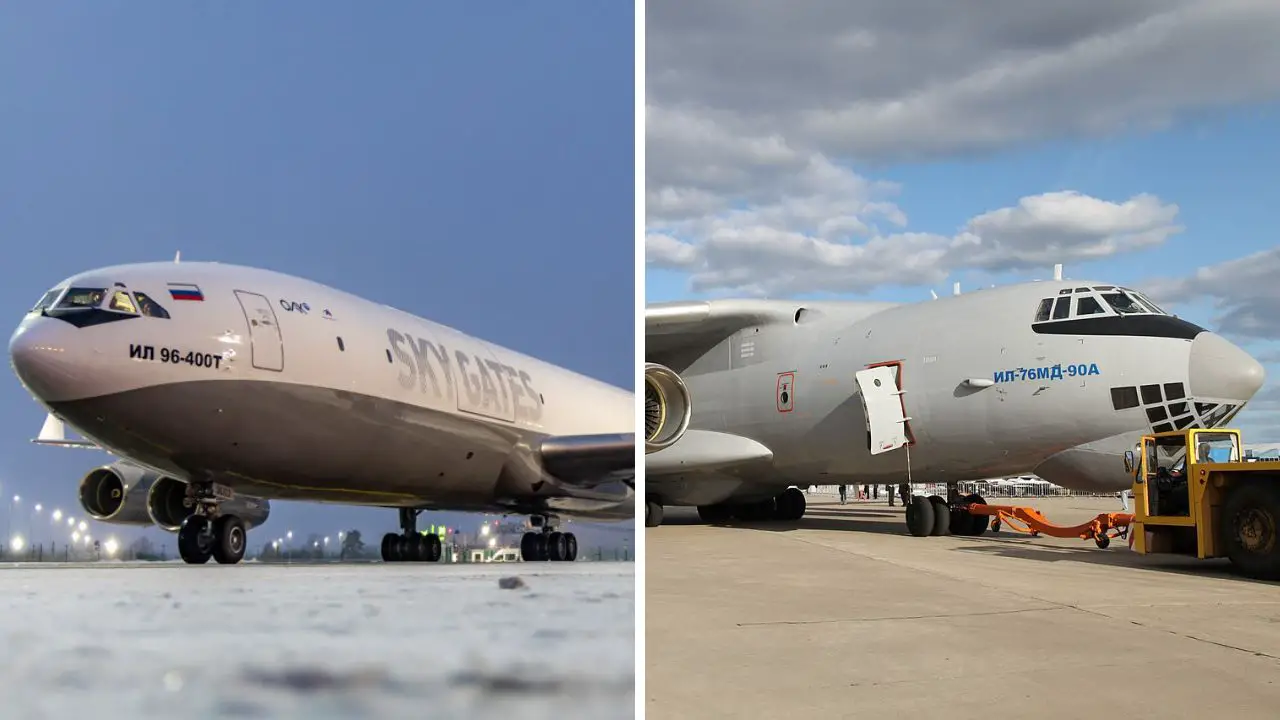The Il-96-400T’s modernization and reintroduction represent significant developments in the civil and military transport sectors of Russia. The Il-96-400T is a wide-body cargo aircraft that is intended to fulfill the requirements of domestic carriers and also function as a strategic reserve for humanitarian and defense missions. It is a long-range aircraft. The Il-96-400T significantly increases the operational reach and nearly doubles the payload compared to the current workhorse, the Il-76, which typically transports around 50 tons over shorter distances. It has a cargo capacity of approximately 92 tons and a range of approximately 11,000 kilometers.
Russia is confronted with the challenge of an aging fleet and restricted access to Western aircraft as a result of ongoing sanctions in civil aviation. This has resulted in the modernization of domestic aircraft, including the Il-96-400T and the MC-21, becoming a strategic priority. The introduction of the Il-96-400T will assist Russian airlines in reducing their dependence on foreign-made aircraft, thereby assuring greater self-sufficiency and resilience in the face of geopolitical pressures. It also has the potential to enhance the efficacy and capacity of domestic cargo operations, which is crucial for supporting Russia’s vast and frequently remote regions.
The Il-96-400T’s enhanced cargo capacity and range significantly enhance Russia’s strategic airlift capabilities from a military perspective. The aircraft’s extended range enables rapid deployment over longer distances, and it can transport a greater number of troops, equipment, or humanitarian assistance in a single flight. This is especially crucial for a nation with the geographic scope and global interests of Russia. The Il-96-400T’s dual-use design enables it to be rapidly converted from civilian to military or humanitarian duties, providing Russian planners with valuable flexibility during periods of crisis or conflict.
IL-76MD-90A versus IL-96-400T
The Il-96-400T and the Il-76MD-90A are two different approaches to large transport aircraft within Russia’s aerospace sector, each uniquely designed to meet specific operational requirements. The Il-96-400T is a modernized, wide-body, long-range cargo aircraft that was predominantly developed for civil use. However, it has a clear dual-use potential for strategic military and humanitarian missions. In contrast, the Il-76MD-90A is a comprehensively modernized version of the classic Il-76, designed for military transport, tactical operations, and airdrop missions.
One of the most notable distinctions between the two is their cargo volume and payload capacity. The Il-96-400T is an excellent choice for transporting oversized or large loads over intercontinental distances, as it can accommodate up to 92 tonnes of cargo in a spacious 776 cubic meter hold. This is nearly twice the payload of the Il-76MD-90A, which is capable of accommodating 52 to 60 tons in a 321 cubic meter cargo compartment. The Il-76MD-90A’s smaller, reinforced hold is optimized for the rapid loading and discharging of military equipment, vehicles, or personnel, often in challenging environments, while the Il-96-400T’s design emphasizes efficiency and capacity for long-haul routes.
The Il-96-400T is also exceptional in terms of range. With a maximum range of approximately 10,400 kilometers at full payload, it is capable of non-stop flights between continents, rendering it suitable for strategic airlift missions similar to those occupied by the American C-5M Super Galaxy. The Il-76MD-90A is more appropriate for regional or theater-level operations, such as supplying frontline bases or conducting airdrops in conflict zones, despite its respectable range of approximately 4,000 kilometers with a maximum payload (and up to 8,500 kilometers with lesser loads).
Additionally, there are substantial variations in the operational environments of these aircraft. The Il-96-400T is intended for use on paved runways and major airports, which restricts its deployment in underdeveloped or austere regions. It is appropriate for global logistics and commercial operations due to its advanced avionics, which are in compliance with international civil aviation standards. On the other hand, the Il-76MD-90A is designed to be both flexible and durable. It is capable of operating from unpaved or semi-prepared airstrips, which is a critical advantage for military missions in remote or hostile regions. Its military-grade systems and modernized glass cockpit facilitate intricate operations, such as the rapid deployment of personnel and equipment and airdrops from various altitudes.
Both aircraft employ sophisticated versions of the Russian PS-90 family engines, but they have undergone distinct optimizations. To facilitate its function as a strategic heavy-lifter, the PS-90A1 engines of the Il-96-400T are optimized for increased fuel efficiency and performance during extended flights. The PS-90A-76 engines of the Il-76MD-90A are designed to deliver optimal performance in challenging operational environments, reduce fuel consumption, and ensure reliability, all of which are consistent with the aircraft’s tactical mission profile.
The Il-96-400T is a critical asset in Russia’s strategic initiative to achieve self-reliance in the aerospace sector. It provides a domestic alternative to Western cargo aircraft and enhances the nation’s capacity to support both civilian and military logistics on a global scale. At the same time, the Il-76MD-90A remains essential for Russia’s ability to quickly transport goods and troops, showing great effectiveness in urgent situations, dropping supplies from the air, and working in places with poor or damaged facilities.
Conclusion
The Il-96-400T’s introduction into service represents a significant stride toward the modernization of Russia’s entire transport fleet. It contributes to the nation’s objective of technological autonomy and mitigates the constraints of an aged fleet. Russia is bolstering its strategic and logistical capabilities and demonstrating its confidence in its domestic aerospace industry through the acquisition of the Il-96-400T. In practical terms, the aircraft’s introduction is expected to lead to improved military readiness, more efficient logistic operations, and a greater capacity to respond to international missions or emergencies.
In conclusion, the Il-96-400T’s return is not merely the revival of a heavyweight aircraft; it is a reaffirmation of the commitment to self-reliance and modernization in both civil and military aviation. The transport infrastructure of Russia will experience tangible benefits as a result of the increased capacity, range, and flexibility it will provide. These benefits will enable the country to more effectively address its domestic requirements and strategic objectives in the years ahead.
Official Website of Youtube Channel – Altitude Addicts
